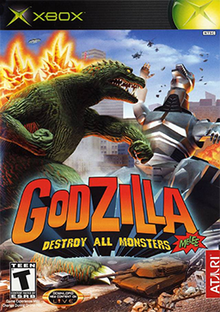
All Star Baseball 2003 is a baseball video game published by Acclaim Entertainment in 2002. The game features Derek Jeter on the cover.
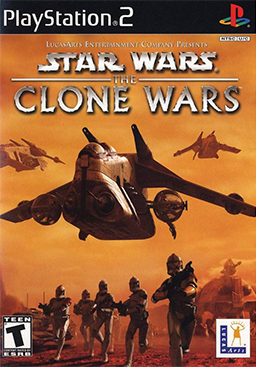
Star Wars: The Clone Wars is a video game set in the Star Wars universe developed by Pandemic Studios and published by LucasArts for GameCube, PlayStation 2 and Xbox. It consists mostly of vehicular combat using clone warships, starfighters, speeder bikes and tanks, as well as missions where players can control Anakin Skywalker, Obi-Wan Kenobi, or Mace Windu on foot. The game is set in the Star Wars prequel trilogy era, with the first level encompassing the Battle for Geonosis from Episode II: Attack of the Clones. The game also features multiplayer modes for up to four players in splitscreen, or online via Xbox Live for the Xbox. It holds aggregate scores of 73 out of 100, 72 out of 100 and 71 out of 100 on review aggregator Metacritic for the GameCube, PlayStation 2, and Xbox, respectively.

Godzilla: Save the Earth is a fighting video game based on Toho's Godzilla franchise. It is developed by Pipeworks Software, published by Atari, and released in 2004 for PlayStation 2 and Xbox.

Dragon Ball Z: Budokai, released as Dragon Ball Z in Japan, is a fighting video game developed by Dimps for PlayStation 2 release in 2002 and GameCube release in 2003. The first game in the Dragon Ball Z: Budokai series, it is based on the Japanese anime series Dragon Ball Z, part of the manga franchise Dragon Ball. It was published in Japan by Bandai and in North America by Infogrames, and was the first console Dragon Ball video game in five years since Dragon Ball GT: Final Bout (1997).

NBA 2K3 is a 2002 sports video game developed by Visual Concepts and published by Sega for GameCube, PlayStation 2 and Xbox.

NBA Live 2003 is the 2002 installment of the NBA Live video games series. The cover features Jason Kidd as a member of the New Jersey Nets. The game was developed by EA Canada and released on October 8, 2002 for the PlayStation, PlayStation 2, Xbox, and GameCube consoles and November 14, 2002 for Microsoft Windows. It was the last NBA Live game to be released on the original PlayStation. The game includes a soundtrack, which is the first video game soundtrack in history to be certified Platinum by the RIAA, selling over 1,300,000 copies worldwide.

Tiger Woods PGA Tour 2004 is a sports video game developed by EA Redwood Shores for the GameCube, PlayStation 2 and Xbox versions, Headgate Studios for the Microsoft Windows version, and Backbone Emeryville for the Game Boy Advance and N-Gage versions, and published by EA Sports for GameCube, Microsoft Windows, PlayStation 2, Xbox, Game Boy Advance and N-Gage.

Outlaw Golf is a series of golf video games developed by Hypnotix, that are intended for adults and mature teens. Outlaw Golf was released for the Xbox on June 11, 2002; for GameCube on October 30, 2002; and for Microsoft Windows on September 30, 2003. A standalone expansion, Outlaw Golf: 9 Holes of X-Mas was released December 23, 2002 exclusively to Blockbuster. A second standalone expansion, Outlaw Golf: 9 More Holes of X-Mas, was released November 15, 2003 also exclusively to Blockbuster. An official sequel, Outlaw Golf 2, was released for Xbox on October 21, 2004, and for PlayStation 2 on November 25, 2004. The games are part of the Outlaw series, and other titles include Outlaw Volleyball and Outlaw Tennis. The Xbox version was released in Japan as part of Xbox World Collection series.

Conflict: Desert Storm is a tactical shooter video game developed by Pivotal Games and published by SCi Games and Gotham Games for Microsoft Windows, PlayStation 2, Xbox, and GameCube; it is the first installment in the Conflict series. Another game of the same name was produced for Mobile phones, developed by Synergenix and published by Kayak Interactive.
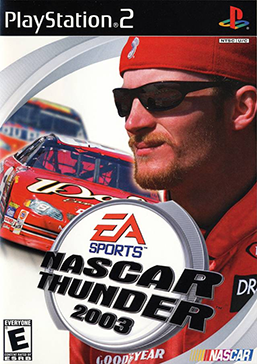
NASCAR Thunder 2003 is the sixth edition of the EA Sports' NASCAR racing simulator series. Developed by EA Tiburon and Budcat Creations and published by EA Sports. It was released for PlayStation, PlayStation 2, GameCube, and Xbox on September 18, 2002, and for Microsoft Windows on October 21. The product features Dale Earnhardt Jr. on the cover. It was the first time the NASCAR's Most Popular Driver Award recipient was featured on the cover, although he did not win the award for the first time until the following year. Dale Earnhardt appeared in the game as a driver as a result of entering his name as a Create-A-Car driver's name; he did not appear in the previous game due to his death. He appeared as a legend in subsequent games.

NFL 2K3 is an American football video game released in 2002 for PlayStation 2, Xbox, and GameCube. It was developed by Visual Concepts and published by Sega. It is the only NFL 2K game for the GameCube. The cover athlete features Brian Urlacher of the Chicago Bears, becoming the first cover athlete in the NFL 2K series besides Randy Moss.

Zapper: One Wicked Cricket! is a platform game for the Xbox, GameCube, PlayStation 2, Game Boy Advance, and Microsoft Windows. For most platforms, it was developed by Blitz Games and published by Infogrames Interactive; Atomic Planet Entertainment developed the Game Boy Advance version. Zapper was released in North America in 2002 and 2003 in Europe. On November 17, 2008, Zapper became available on Xbox Live as part of the Xbox Originals range.
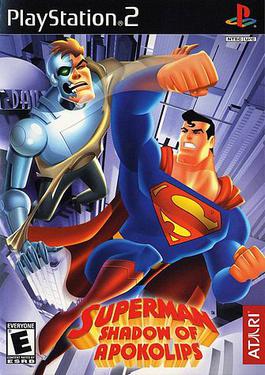
Superman: Shadow of Apokolips is a video game that was released in 2002 for the PlayStation 2 and GameCube consoles. It was developed by Infogrames Sheffield House, published by Infogrames under the Atari brand name, and released in conjunction with Warner Bros. Interactive Entertainment and DC Comics. It is based on the television series Superman: The Animated Series.

Kelly Slater's Pro Surfer is an extreme sports video game developed by Treyarch and published by Activision under the Activision O2 label. The game was endorsed by veteran surfer Kelly Slater and released for Game Boy Advance, GameCube, PlayStation 2 and Xbox in 2002, and for Microsoft Windows in 2003. To coincide with the game, Slater appeared as an unlockable character in the 2001 skateboarding video game Tony Hawk's Pro Skater 3, complete with surfboard.
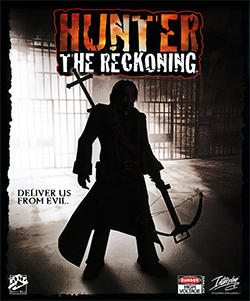
Hunter: The Reckoning is a 2002 hack-and-slash third-person shooter video game developed by High Voltage Software and published by Interplay Entertainment for the Xbox and GameCube. It is based on the tabletop role-playing game of the same name, and is part of the larger World of Darkness series. Two sequels, Wayward and Redeemer, were both released in 2003.

NHL 2003 is an ice hockey video game developed by EA Canada and published by EA Sports. It was released in 2002 as the successor to NHL 2002. Jarome Iginla appears as the cover athlete and spokesperson of the game. Iginla appears in the Behind The Scenes video to show the player how the game was made. It was the first installment of the NHL series to be released on GameCube.

NHL 2K3 is an ice hockey video game developed for the GameCube, PlayStation 2, and Xbox by Treyarch and published by Sega. Jeremy Roenick is on the cover. It is the only game in the NHL 2K series to be released for GameCube. NHL 2K3 uses ESPN's presentation and was the first hockey game with support for PS2 Online and Xbox Live online services. The rosters are from the 2002–2003 NHL season.

Starsky & Hutch is a vehicular combat video game by British studio Mind's Eye Productions and published by Empire Interactive based on the television series of the same name created by William Blinn. The game was released for Microsoft Windows, PlayStation 2, Xbox, Game Boy Advance and GameCube.

Godzilla: Unleashed is a 3D fighting video game based on Toho's Godzilla franchise. It was developed by Pipeworks Software and published by Atari. The game was released in North America on November 20, 2007 for PlayStation 2; and on December 5 of the same year for the Wii. A Nintendo DS version, titled Godzilla Unleashed: Double Smash, was also released in North America on December 5, 2007.
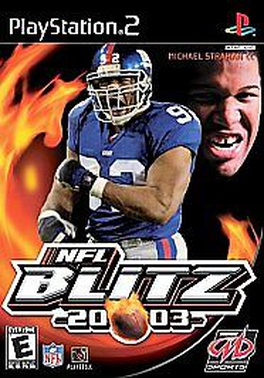
NFL Blitz 2003 is a video game published by Midway Sports for Game Boy Advance, GameCube, PlayStation 2 and Xbox in 2002.
